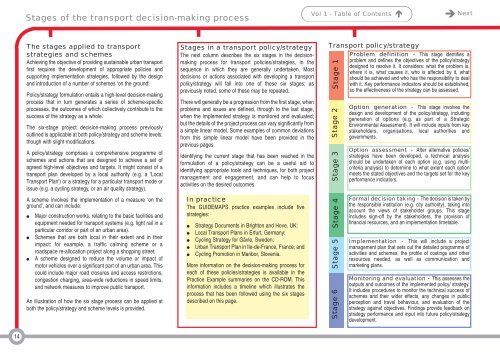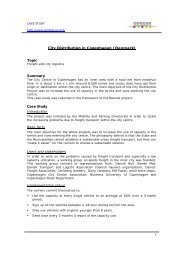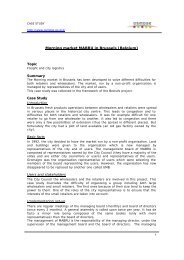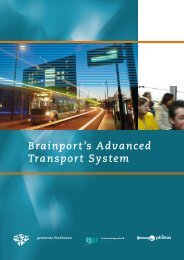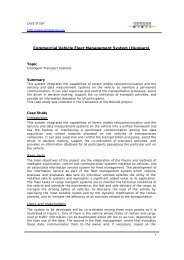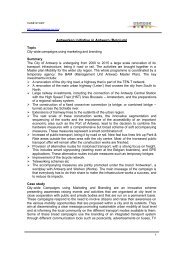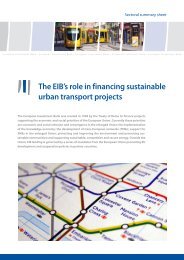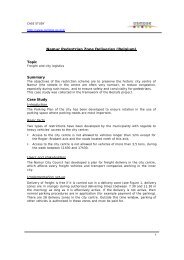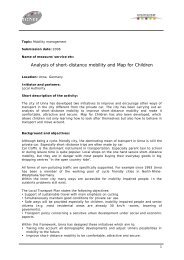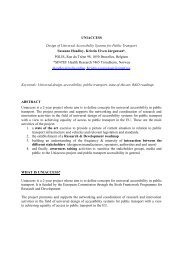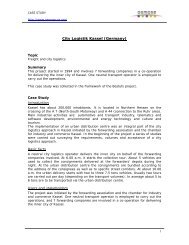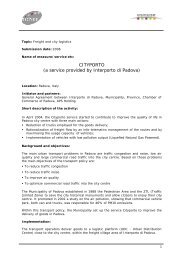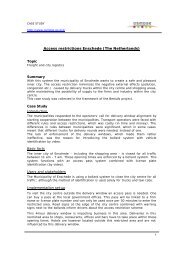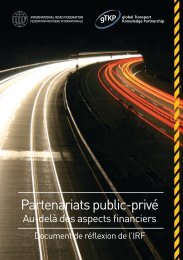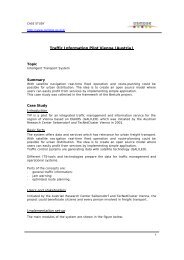Successful transport decision-making - Osmose
Successful transport decision-making - Osmose
Successful transport decision-making - Osmose
Create successful ePaper yourself
Turn your PDF publications into a flip-book with our unique Google optimized e-Paper software.
Stages of the <strong>transport</strong> <strong>decision</strong>-<strong>making</strong> process<br />
Vol 1 - Table of Contents <br />
Next<br />
The stages applied to <strong>transport</strong><br />
strategies and schemes<br />
Achieving the objective of providing sustainable urban <strong>transport</strong><br />
first requires the development of appropriate policies and<br />
supporting implementation strategies, followed by the design<br />
and introduction of a number of schemes 'on the ground'.<br />
Policy/strategy formulation entails a high-level <strong>decision</strong>-<strong>making</strong><br />
process that in turn generates a series of scheme-specific<br />
processes, the outcomes of which collectively contribute to the<br />
success of the strategy as a whole.<br />
The six-stage project <strong>decision</strong>-<strong>making</strong> process previously<br />
outlined is applicable at both policy/strategy and scheme levels,<br />
though with slight modifications.<br />
A policy/strategy comprises a comprehensive programme of<br />
schemes and actions that are designed to achieve a set of<br />
agreed high-level objectives and targets. It might consist of a<br />
<strong>transport</strong> plan developed by a local authority (e.g. a 'Local<br />
Transport Plan') or a strategy for a particular <strong>transport</strong> mode or<br />
issue (e.g. a cycling strategy, or an air quality strategy).<br />
A scheme involves the implementation of a measure ‘on the<br />
ground’, and can include:<br />
<br />
<br />
<br />
Major construction works, relating to the basic facilities and<br />
equipment needed for <strong>transport</strong> systems (e.g. light rail in a<br />
particular corridor or part of an urban area).<br />
Schemes that are both local in their extent and in their<br />
impact: for example, a traffic calming scheme or a<br />
roadspace re-allocation project along a shopping street.<br />
A scheme designed to reduce the volume or impact of<br />
motor vehicles over a significant part of an urban area. This<br />
could include major road closures and access restrictions,<br />
congestion charging, area-wide reductions in speed limits,<br />
and network measures to improve public <strong>transport</strong>.<br />
An illustration of how the six stage process can be applied at<br />
both the policy/strategy and scheme levels is provided.<br />
Stages in a <strong>transport</strong> policy/strategy<br />
The next column describes the six stages in the <strong>decision</strong><strong>making</strong><br />
process for <strong>transport</strong> policies/strategies, in the<br />
sequence in which they are generally undertaken. Most<br />
<strong>decision</strong>s or actions associated with developing a <strong>transport</strong><br />
policy/strategy will fall into one of these six stages; as<br />
previously noted, some of these may be repeated.<br />
There will generally be a progression from the first stage, when<br />
problems and issues are defined, through to the last stage,<br />
when the implemented strategy is monitored and evaluated;<br />
but the details of the project process can vary significantly from<br />
a simple linear model. Some examples of common deviations<br />
from this simple linear model have been provided in the<br />
previous pages.<br />
Identifying the current stage that has been reached in the<br />
formulation of a policy/strategy can be a useful aid to<br />
identifying appropriate tools and techniques, for both project<br />
management and engagement, and can help to focus<br />
activities on the desired outcomes.<br />
In practice<br />
The GUIDEMAPS practice examples include five<br />
strategies:<br />
<br />
<br />
<br />
<br />
<br />
Strategy Documents in Brighton and Hove, UK;<br />
Local Transport Plans in Erfurt, Germany;<br />
Cycling Strategy for Gävle, Sweden;<br />
Urban Transport Plan in Ile-de-France, France; and<br />
Cycling Promotion in Maribor, Slovenia.<br />
More information on the <strong>decision</strong>-<strong>making</strong> process for<br />
each of these policies/strategies is available in the<br />
Practice Example summaries on the CD-ROM. This<br />
information includes a timeline which illustrates the<br />
process that has been followed using the six stages<br />
described on this page.<br />
Transport policy/strategy<br />
Problem definition - This stage identifies a<br />
problem and defines the objectives of the policy/strategy<br />
designed to resolve it. It considers: what the problem is,<br />
where it is, what causes it, who is affected by it, what<br />
should be achieved and who has the responsibility to deal<br />
with it. Key performance indicators should be established,<br />
so the effectiveness of the strategy can be assessed.<br />
Stage 1<br />
Stage 2<br />
Stage 3<br />
Stage 4<br />
Stage 5<br />
Stage 6<br />
Option generation - This stage involves the<br />
design and development of the policy/strategy, including<br />
generation of options (e.g. as part of a Strategic<br />
Environmental Assessment). It will include inputs from key<br />
stakeholders, organisations, local authorities and<br />
governments.<br />
Option assessment - After alternative policies/<br />
strategies have been developed, a technical analysis<br />
should be undertaken of each option (e.g. using multicriteria<br />
analysis) to determine to what extent each option<br />
meets the stated objectives and the targets set for the key<br />
performance indicators.<br />
Formal <strong>decision</strong> taking - The <strong>decision</strong> is taken by<br />
the responsible institution (e.g. city authority), taking into<br />
account the views of stakeholder groups. This stage<br />
includes sign-off by the stakeholders, the provision of<br />
financial resources, and an implementation timetable.<br />
Implementation - This will include a project<br />
management plan that sets out the detailed programme of<br />
activities and schemes, the profile of costings and other<br />
resources needed, as well as communication and<br />
marketing plans.<br />
Monitoring and evaluation - This assesses the<br />
outputs and outcomes of the implemented policy/ strategy.<br />
It includes procedures to monitor the technical success of<br />
schemes and their wider effects, any changes in public<br />
perception and travel behaviour, and evaluation of the<br />
strategy against objectives. Findings provide feedback on<br />
strategy performance and input into future policy/strategy<br />
development.<br />
14


